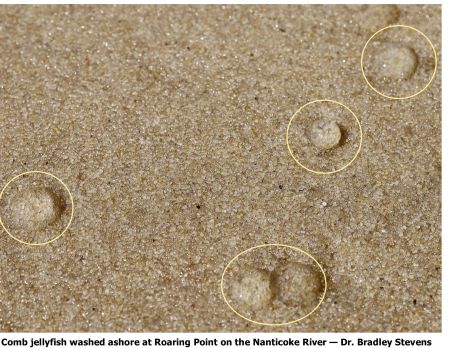
By Dr. Bradley Stevens
On a beautiful Sunday afternoon at Roaring Point Park on the Nanticoke River, the beach was covered with bathers enjoying the warm weather and water.
Most of them probably didn’t even notice the little transparent glistening globules beside them on the beach.
As I walked along the beach, though, my eyes were drawn to them because they sparkled like diamonds in the sun. At some locations, hundreds collected in depressions as the tide receded.
I thought it remarkable that so many would be present at one time and place, but then again, maybe not.
As I waded out to chest deep water to cool off, I could feel little bumps against my hands and fingers as I moved them through the water. Back on the beach, I realized that I had been wading through a soup of comb jellies, or ctenophores, most only the size of my fingernails.
Sea walnuts
Comb jellies are clear gelatinous marine organisms, but they are not closely related to other jellyfish.
The most common ctenophore in the mid- to upper Chesapeake Bay is known as Mnemiopsis leidyi (nee-me-opsis lee-dee-eye). Also known as the sea walnut, it is about the size and shape of a walnut and can reach five inches in diameter.
Unlike the sea nettle, a jellyfish with stinging tentacles common in the Bay, comb jellies do not sting, and do not have tentacles.
Instead, they are covered with eight rows of overlapping comb-like plates (thus their name), that rake up and down, providing them with a means of locomotion, and produce flashing displays of iridescent color.

Comb jellies are voracious predators of plankton, especially small crustaceans known as copepods, as well as fish eggs and larvae.
When comb jellies are abundant, they can totally eliminate fish from an ecosystem.
This actually happened in the Black Sea, where comb jellies are invasive, brought in by ship ballast water.
Ctenophores were introduced there in the 1990s and caused a massive collapse of fisheries in the region, then spread to the Caspian Sea. In the early 2000s they were found in the Aegean and Adriatic seas as well, raising concerns about fish populations there.
Fortunately, comb jellies have their own predator, the sea nettle (recently renamed as Chrysaora chesapeakei).
In the (Chesapeake) Bay, ctenophore populations bloom in spring and early summer, but are largely consumed by sea nettles in July-August, which reduces the comb jelly populations significantly. Although the nettles are a nuisance to swimmers, they’re a great benefit to fishermen
Diamonds on beach
On that afternoon, I was amazed and puzzled to see so many small (half-inch) ctenophores washed up on the beach. On a lark, I returned the next day to see whether they were still there. Same time of day, same stage of tide (high), but no ctenophores.
I walked the entire beach without seeing any, then decided to cool off in the water and wait for a bit. An hour later, the tide started to turn, and a few little diamonds sparkled on the beach. As the tide receded, more and more of them appeared, stranded by the waves.
There weren’t nearly as many as the day before, however, and I never felt them bouncing off my hands in the water.
I’m left with a conundrum.
On one day I witnessed an amazing spectacle — thousands of juvenile comb jellies washed up on the shoreline among oblivious beach-goers — and the next day, only a hint of a similar event.
But why? My guess is that the combination of wind (southerly) and tide was just right to concentrate thousands (millions?) of ctenophores onto the beach Sunday.
As for Monday, perhaps they had been blown farther upriver, or maybe I just didn’t wait around long enough for the tide to recede.
Nature is full of wonders. Too often, we are so busy with our own concerns that we are oblivious to her charms.
The opportunity to witness such a massive stranding event was like peering through a magical window into nature’s secrets. In the big scheme of things, it probably has little impact on overall comb jelly populations.
But nonetheless, it’s not something we get to see every day. So next time you are on the beach, look around. You might be witnessing some amazing natural event, and not even know it.
Dr. Bradley Stevens of Salisbury is newly retired from the University of Maryland Eastern Shore, where he was a professor of marine science. This guest column was published in the Sept. 16, 2021 edition of The Salisbury Independent and is reproduced here with that publication’s permission.

